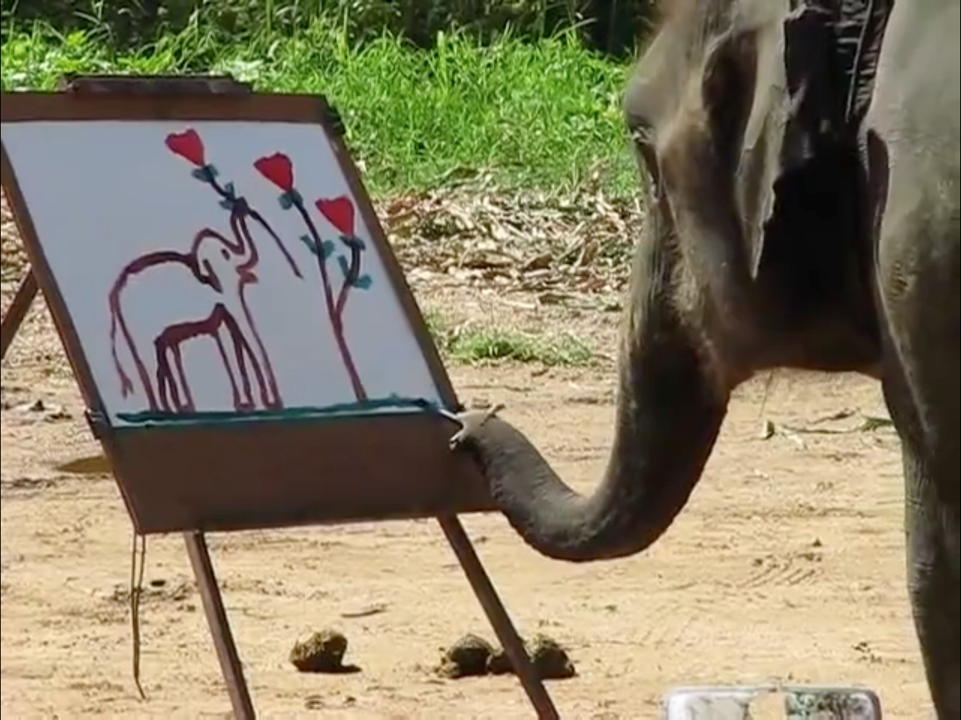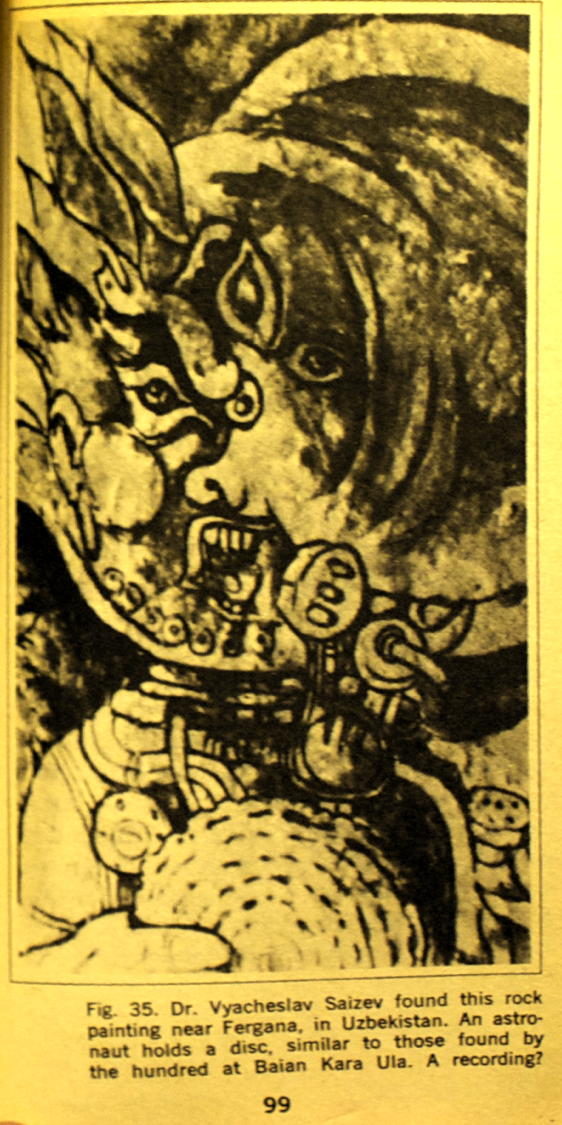The Art of the Elephants (and other ancient astronauts)

Tourists recorded this elephant painting a self-portrait in Thailand. The elephant is finishing up the grass by drawing a solid line across the bottom of the canvas. Intelligent pachyderms?
I saw this elephant painting video a few days ago on Facebook, and it’s been bugging me ever since. I just realized last night why: it reminds me of something I read when I was in high school. I used to read a lot of Erich von Däniken•. The title of this post is a play on his The Gold of the Gods•. Back in the seventies, his Chariots of the Gods• was a fascinating theory. Taken together, all of these stick figures, Mayan glyphs, and giant Nazca lines seemed to open the possibility of influence by a technologically advanced civilization. I bought and devoured his books as soon as they showed up in the paperback aisle in the local Meier Thrifty Acres.
Right up until The Gold of the Gods•. In Gold of the Gods there’s a “rock painting” of an ancient astronaut in a space suit, wearing a helmet with an attached microphone and holding a recording. Von Däniken could have ended his book right there: there was simply no explanation other than that the drawing was an ancient astronaut. If it was truly ancient, it was absolute proof to any reasonable person.
Von Däniken gives it barely a paragraph, and expresses disappointment that related documents are not in the Palace Museum of Taipeh when he visits China. This absolute proof of his theories, which deserved a book in itself, is given no more space than snakes with triangular heads and vague shrouds that could be representations of “a space traveler’s mask”.
The drawing was even alien-looking… most likely because I was unfamiliar with Russian art styles. The ancient drawing turns out to be a 1967 painting in Sputnik magazine. I didn’t know that at the time, however. What I knew was that Erich von Däniken did not believe his own theories. If he did, he would have tracked down that rock painting and either made it the central piece of his book or discounted it as fake.
That’s what these elephant paintings remind me of. If they are what they are presented as, they are absolute proof of animals with an intelligence equal to humans and yet they’re used as tourist attractions.
There are far too many abstractions going on for any explanation other than human-level intelligence. Worse, though, the paintings all match what a human perceives—and how humans use their intelligence to abstract four dimensions down to two.
From the use of partial outlines returned to later, to a single flat green line for grass, to the choice of what to draw using each color the elephant is handed—that green looks no more like plant green than it looks like elephant grey.
And, finally, the use of arbitrary symbols to indicate self. In English. In Thailand.
Unlike the Uzbekistan paintings, there is nothing alien about these drawings. There is nothing in them that makes me think that an elephant created them and a human did not. For example, elephant vision is very different from human vision. Elephants do not have binocular vision, but do have a much greater peripheral vision than humans. None of that is apparent in these elephant self-portraits. They look like they were painted by someone with human anatomy and the human thoughts that come from them. They could just as well have been painted by a talented child still lacking fine motor skills.
And that turns out to be close to what’s going on: these paintings are created by humans using the elephant as a reverse Waldo. The elephants always paint a similar picture, and if they get off course they have been trained to respond to light touches on their ears, which are very sensitive to touch. There is also a strong possibility that their training is abusive.
This got me thinking, though. When we really see what a non-human intelligence looks like, how will that change the animal intelligence movement?
There is this sense in science fiction that future man will voluntarily become effete plant-eaters unwilling to eat their equals in the animal kingdom, but I suspect that once we meet extraterrestrials we will shed all illusions about the intelligence of pigs and cows, and probably even dolphins and elephants. The presence of another true intelligence will make it more clear what intelligence means, and we won’t have to go desperately searching for it in places where it doesn’t exist.
ancient astronauts
- Chariots of the Gods•: Erich von Däniken
- “…the first book to introduce the shocking theory that ancient Earth had been visited by aliens. This world-famous bestseller has withstood the test of time, inspiring countless books and films. But here is where it all began—von Daniken’s startling theories of our earliest encounters with alien worlds, based upon his lifelong studies of ancient ruins, lost cities, potential spaceports, and a myriad of hard scientific facts that point to extraterrestrial intervention in human history.”
- Faking Ancient Art in Uzbekistan: Jason Colavito
- “In The Gold of the Gods, Erich von Däniken makes an astonishing claim about a cave painting in Uzbekistan, a painting he argues is proof that ancient humans drew images of the aliens who came to earth in prehistory, around the time that (fake) stone plates (see below) recorded their coming.”
- The Gold of the Gods•: Erich von Däniken
- Erich von Däniken visits China to see crude drawings of turtles and vague hints while practically ignoring absolute proof of his theories in Uzbekistan.
- Traces of the Gods in China, Too: Erich von Däniken
- “You are a visionary! But of course you’re not forced to kowtow to traditional explanations. Perhaps modern interpretations of myths and legends are justified, perhaps they will throw new light on things. There is a lot we don’t know yet.”
elephants
- Can jumbo elephants really paint? Intrigued by stories, naturalist Desmond Morris set out to find the truth: Desmond Morris
- “He nudges it up and down to get the animal to make a vertical line, or pulls it sideways to get a horizontal one. To encourage spots and blobs he tugs the ear forward, towards the canvas. So, very sadly, the design the elephant is making is not hers but his. There is no elephantine invention, no creativity, just slavish copying.”
- Elephant Painting at Snopes.com
- “The training process is called the ‘pajaan’ or ‘crush’ and is centuries old and is used throughout Asia today. It involves taking a 3-year-old baby from its mother’s side and roping it into a small bamboo cage in which it cannot move except to breathe. Of course the elephant fights for its freedom and is beaten, poked with sharp bamboo, starved, dehydrated, and sleep-deprived until it submits to its captors’ demands. The process may take a week, depending on how long it takes to ‘crush’ the elephant’s spirit. About 50% of the babies die from the process and the survivors are left with physical and emotional scars for the rest of their lives.”
- Do elephants really paint?: Windy Borman
- “From what I’ve heard from such elephant experts as Soraida Salwala (founder of the Friends of the Asian Elephant Hospital), Lek Chailert (founder of the Elephant Nature Park), Pat Derby (founder of Performing Animals Welfare Society) and Don Tayloe (director of “The Last Elephants in Thailand”), elephant paintings, such as the one pictured below, are a learned trick that elephants at tourist camps are forced to learn by their owners/handlers, similar to how elephants in circuses are trained/beaten.”
- Original Elephant Painting
- “Watch this elephant paint a beautiful image of an elephant holding a flower. You’ll be amazed at how her talent unfolds as she carefully completes each stroke. Her mahout talks to her throughout the process as his gentle touch gives her confidence.”
- Suda—The Painting Elephant
- “This is a video I shot of a 4 year old elephant named Suda painting a picture of herself at the Maetaeng Elephant Camp in Chiang Mai, Thailand.”


Hey there I was wondering where I could buy a painting that Suda has painted. Could you possibly find out for me please?!
Marti in Saskatchewan Canada at 3:03 a.m. April 25th, 2014
dbtHn
If you do a Google search for “suda paintings” it should show up at the top of the listing, right above the Snopes.Com result.
Jerry Stratton in Round Rock, TX at 7:44 p.m. April 25th, 2014
VekeO